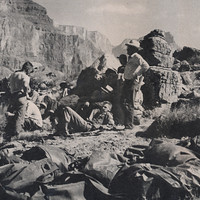National Park Service Creates an Historic Landmark that can’t be Visited
 Recovery team with filled body bags at Grand Canyon crash site in 1956 (photo: Getty/LIFE)
Recovery team with filled body bags at Grand Canyon crash site in 1956 (photo: Getty/LIFE)
A remote stretch of the Grand Canyon has been declared a historic landmark to commemorate a fatal plane crash that proved instrumental in the development of U.S. aviation. But Americans won’t be able to visit the landmark because the National Park Service (NPS) intends to keep its location a secret.
The landmark covers an area of rugged terrain about 1.5 square miles in size within the Grand Canyon, above which two planes collided in midair on June 30, 1956.
Flying in inclement weather, a United Airlines Douglas DC-7 crashed into a TWA Lockheed L-1049 Super Constellation. All 128 people aboard the two planes were killed, making it the deadliest accident in commercial aviation history at the time.
The accident prompted the federal government to expand its regulatory authority over the industry, culminating in the establishment of the Federal Aviation Administration two years later.
It also encouraged the development of nationwide radar, collision avoidance systems, flight-data recorders, and more advanced navigation equipment.
Given the turning points in aviation operations that followed the crash, NPS officials decided it was time to designate the area as a historic landmark.
Alexandra Lord, branch chief of the National Historic Landmarks Program in Washington, DC, admits the marker represents the first time the agency has given such a designation to a crash site. It also may be the first time that a landmark was created for something that happened exclusively in the air.
“In some ways we can argue that the crash itself—which led to the scattering of pieces over a huge debris field—is what's crucial. And it sort of doesn't matter if you think of it as on the air or on the ground,” Lord told The Atlantic.
Efforts were made to retrieve human remains after the accident, but no bodies were found intact, making identification difficult or impossible. The remains of 29 United victims were buried in four coffins, and 66 of the 70 TWA passengers were interred in a mass grave.
Although most of the wreckage was removed, to this day the area reportedly still contains some remnants of the destroyed aircrafts.
Hikers have been banned from the area since the 1950s, but it wouldn’t be wise anyway for the curious to make the trek, advised Lord. “It’s extremely remote, so it would take a very long time for someone to get there backpacking and it would be very difficult to reach,” she said.
One man did reach the crash site a year after the disaster. He claimed to have found various items from the planes, including some burnt coins and a TWA spoon.
The NPS wants to preserve the area and consequently won’t reveal the site’s coordinates. In fact, it redacted that information from the Historic Landmark Nomination document (pdf). “But we know where it is,” said Lord, “and we're going to work to preserve it.”
-Noel Brinkerhoff
To Learn More:
The Site of a 1950s Plane Crash Just Became a National Landmark (by Adrienne LaFrance, The Atlantic)
National Historic Landmark Nomination (National Parks Service) (pdf)
1956 Grand Canyon Mid-air Collision (Wikipedia)
- Top Stories
- Unusual News
- Where is the Money Going?
- Controversies
- U.S. and the World
- Appointments and Resignations
- Latest News
- Musk and Trump Fire Members of Congress
- Trump Calls for Violent Street Demonstrations Against Himself
- Trump Changes Name of Republican Party
- The 2024 Election By the Numbers
- Bashar al-Assad—The Fall of a Rabid AntiSemite






Comments